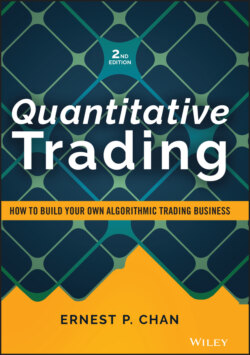Читать книгу Quantitative Trading - Ernest P. Chan - Страница 11
WHO CAN BECOME A QUANTITATIVE TRADER?
ОглавлениеIt is true that most institutional quantitative traders received their advanced degrees as physicists, mathematicians, engineers, or computer scientists. This kind of training in the hard sciences is often necessary when you want to analyze or trade complex derivative instruments. But those instruments are not the focus in this book. There is no law stating that one can become wealthy only by working with complicated financial instruments. (In fact, one can become quite poor trading complex mortgage-backed securities, as the financial crisis of 2007–08 and the demise of Bear Stearns have shown.) The kind of quantitative trading I focus on is called statistical arbitrage trading. Statistical arbitrage deals with the simplest financial instruments: stocks, futures, and sometimes currencies. One does not need an advanced degree to become a statistical arbitrage trader. If you have taken a few high school–level courses in math, statistics, computer programming, or economics, you are probably as qualified as anyone to tackle some of the basic statistical arbitrage strategies.
Okay, you say, you don't need an advanced degree, but surely it gives you an edge in statistical arbitrage trading? Not necessarily. I received a PhD from one of the top physics departments of the world (Cornell University). I worked as a successful researcher in one of the top computer science research groups in the world (at that temple of high-techdom: IBM's T. J. Watson Research Center). Then I worked in a string of top investment banks and hedge funds as a researcher and finally trader, including Morgan Stanley, Credit Suisse, and so on. As a researcher and trader in these august institutions, I had always strived to use some of the advanced mathematical techniques and training that I possessed and applied them to statistical arbitrage trading. Hundreds of millions of dollars of trades later, what was the result? Losses, more losses, and losses as far as the eye can see, for my employers and their investors. Finally, I quit the financial industry in frustration, set up a spare bedroom in my home as my trading office, and started to trade the simplest but still quantitative strategies I know. These are strategies that any smart high school student can easily research and execute. For the first time in my life, my trading strategies became profitable (one of which is described in Example 3.6), and has been the case ever since. The lesson I learned? A famous quote, often attributed to Albert Einstein, sums it up: “Make everything as simple as possible. But not simpler.”
(Stay tuned: I will detail more reasons why independent traders can beat institutional money managers at their own game in Chapter 8.)
Though I became a quantitative trader through a fairly traditional path, many others didn't. Who are the typical independent quantitative traders? Among people I know, they include a former trader at a hedge fund that has gone out of business, a computer programmer who used to work for a brokerage, a former trader at one of the exchanges, a former investment banker, a former biochemist, and an architect. Some of them have received advanced technical training, but others have only basic familiarity of high school–level statistics. Most of them backtest their strategies using basic tools like Excel, though others hire programming contractors to help. Most of them have at some point in their career been professionally involved with the financial world but have now decided that being independent suits their needs better. As far as I know, most of them are doing quite well on their own, while enjoying the enormous freedom that independence brings.
Besides having gained some knowledge of finance through their former jobs, the fact that these traders have saved up a nest egg for their independent venture is obviously important, too. When one plunges into independent trading, fear of losses and of being isolated from the rest of the world is natural, and so it helps to have both a prior appreciation of risks and some savings to lean on. It is important not to have a need for immediate profits to sustain your daily living, as strategies have intrinsic rates of returns that cannot be hurried (see Chapter 6).
Instead of fear, some of you are planning to trade because of the love of thrill and danger, or an incredible self-confidence that instant wealth is imminent. This is also a dangerous emotion to bring to independent quantitative trading. As I hope to persuade you in this chapter and in the rest of the book, instant wealth is not the objective of quantitative trading.
The ideal independent quantitative trader is therefore someone who has some prior experience with finance or computer programming, who has enough savings to withstand the inevitable losses and periods without income, and whose emotion has found the right balance between fear and greed.
